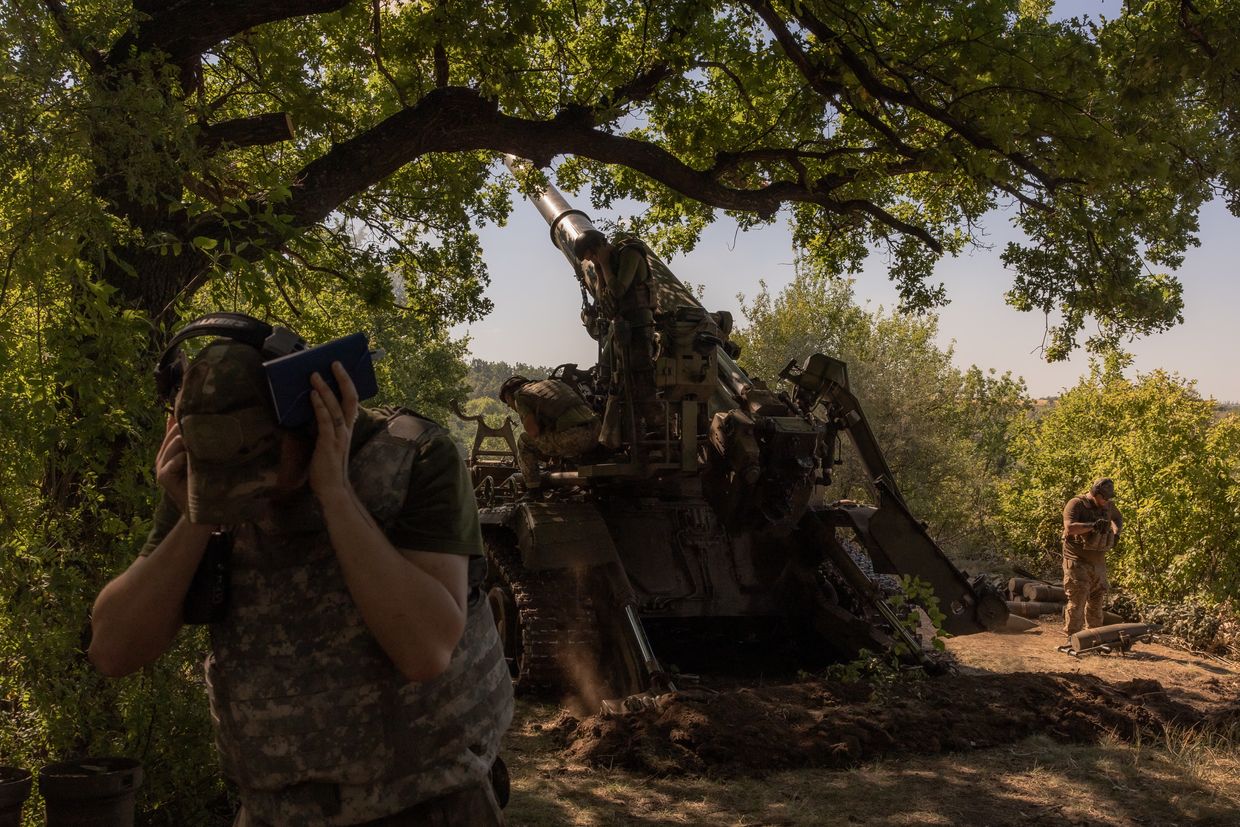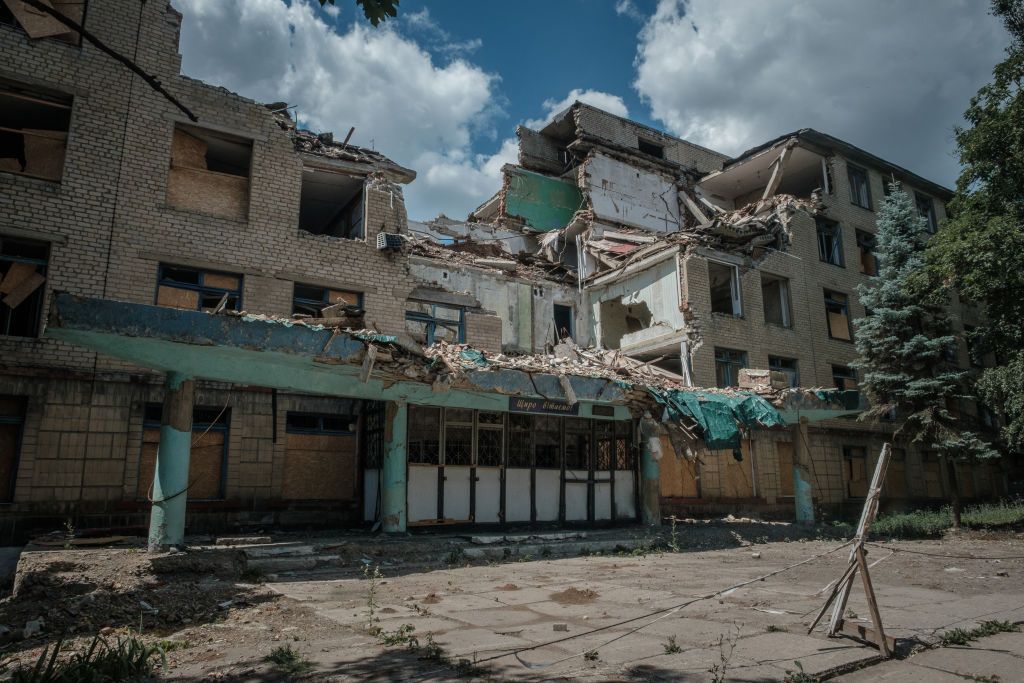
Russia ramps up offensive on Vuhledar, Ukrainian stronghold in the east
Ukrainian soldiers of 79th brigade are seen in the front line city of Vuhledar as Russia-Ukraine war continues in Donetsk Oblast, Ukraine on March 12, 2024. (Wolfgang Schwan/Anadolu via Getty Images)
While the Russian advance on Pokrovsk had slightly slowed down in recent days, Vuhledar, in the southern part of Donetsk Oblast, became a new focal point of the ongoing Russian offensive.
Located 50 kilometers south of Pokrovsk, Vuhledar is often referred to as a "fortress" among the military and has been under consistent Russian attacks since the beginning of the full-scale invasion.
As part of the most recent wave of offensives in Donetsk Oblast, Russian troops resumed their assault on the city. Although not a logistics hub like Pokrovsk, the city is key to Ukraine's defenses on the southern front, the loss of which could significantly impact military operations in the area.
"The loss of Vuhledar would be not only a morale blow for Ukraine since this city has resisted plenty of assaults since 2022, but also a very serious development that can potentially threaten the security of the entire southwestern portion of Donetsk Oblast not yet occupied, along with the threat to Pokrovsk's southern flank," Federico Borsari, a fellow at the Center for European Policy Analysis (CEPA), told the Kyiv Independent.
Why does Russia keep trying to seize Vuhledar?
The small mining town of Vuhledar, where about a hundred people remained as of February 2024, according to Suspilne, is located north of a key intersection connecting the O-0532 road towards Vodiane and Kostiantynivka, a small paved road toward Kurakhove and the partly occupied T-0509 highway toward Velyka Novosilka.
"It is, therefore, a key logistic point for Ukrainian forces defending the southern flank of Kurakhove," Borsari said.
Given the Russian significant advance towards Pokrovsk from the east in recent weeks, Ukrainian forces need to avoid a similar development from the south to avoid the risk of encirclement, Borsari added.

The expert noted that the occupied section of the T-0509 highway, which passes south of Vuhledar, is essential for Russian forces trying to advance westward. Vuhledar is also the last fortified town before the village of Velyka Novosilka and the entire southern part of Donetsk Oblast that Ukraine controls.
Russia has long said that its goal is to occupy Ukraine's Donetsk Oblast, and Vuhledar was one of the towns that had long been standing in the way of this, Dmytro Zhmaylo, co-founder and executive director of the Ukrainian Security and Cooperation Center, told the Kyiv Independent.
"Ideological requirements, as well as information and psychological ones, often dictate military objectives for the Russians," Zhmaylo said.
Why can't Russia conquer it?
Vuhledar, home to 14,000 people before the war, and its surroundings are heavily urbanized and lie on higher ground, making the territory difficult to seize. The town has also been close to the front line since the beginning of the Russian-Ukrainian war in 2014, so it has been well-fortified in case of a potential Russian offensive.
Dense buildings and a small area create conditions for more effective strikes by the Ukrainian military. Russian troops, limited in their maneuvers by urban construction and concrete fortifications, tend to concentrate in one place, making it easier to hit them with artillery and aircraft, said Zhmaylo.
"Our tactic is simply to wipe out the Russians in their attacks while we stand in a stalemate. That's why we hold on to the cities," Zhmaylo added.
Zhmaylo said that Russian troops were pushed out of the eastern part of the town of Selydove, nearly 40 kilometers (24 miles) north of Vuhledar, for the same reasons: when Ukrainian forces brought in reserves, Russian soldiers were unable to gain a foothold in the densely built-up area.
"The enemy's difficulties lie in that our artillery is operating, and we (Ukraine) are on a hill. This situation is partially comparable to the conditions in Chasiv Yar, but unfortunately, Vuhledar does not have such solid water barriers around," Zhmaylo said.
Russia has attempted to attack Vuhledar directly instead of from the flanks, but it ended "very badly" for them, Emil Kastehelmi, an analyst at the Finland-based Black Bird Group, told the Kyiv Independent.

During the recent offensive, Russian troops changed their strategy, trying to approach Vuhledar from the flanks to force the Ukrainian military out of the city at the risk of being surrounded.
"There is still a long way before the town of Vuhledar would actually be encircled. So, the Russians would have to make at least locally significant gains to actually create a proper encirclement threat," Kastehelmi said.
How far did Russian troops advance in the area?
In early September, Russian troops made a number of advances not far from Vuhledar.
Russian troops made gains near the settlements of Hirnyk and Ukrainsk, approaching Kurakhove from the north, managed to occupy the village of Prechystivka, approaching Vuhledar from the southwest, and took over Vodiane, closing in on Vuhledar from the northeast.
Russia is now focusing on capturing smaller settlements with unfortified areas, realizing that it lacks the personnel to take Vuhledar in one push, Zhmaylo said.
"The Russians went all-in," he said.
"The Russians are trying to stretch our reserves, and we are trying to do the same in Kursk Oblast to reduce their offensive potential. In general, the areas of the front line where Russia can advance quickly are quite limited," Zhmaylo said.

Despite Ukraine's hopes of forcing Russia to redeploy troops from Donetsk Oblast to defend the country's Kursk Oblast, over 350 kilometers northwest, no withdrawal has been recorded so far.
"The Russian strategy now seems to be centered on gradual advances along multiple mutually supporting lines of advance rather than disjointed heavy mechanized assaults in order to achieve breakthroughs as in 2022-2023," Borsari said.
"This confirms Russian learning and adaptation after multiple failed attempts to advance in this area that caused enormous losses."
"Russia (also) often has reserves available to try rapid advances when it identifies gaps or weak points in Ukrainian defenses, as seen east of Pokrovsk in recent weeks," he added.












